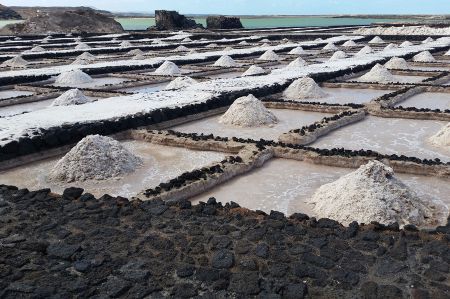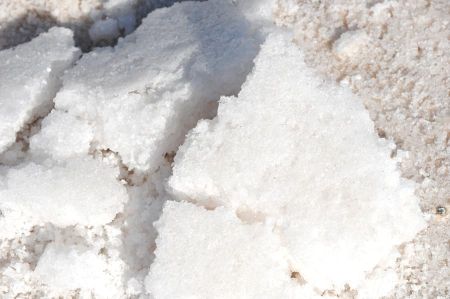Salt - white gold of mankind since centuries
- Written by Portal Editor
A problem in nutrition was also very closely linked to the transition of people from gatherers and hunters to the cultivation of grain and vegetables.
The physical need for salts and minerals has hitherto been covered in a simple manner by the various animal products on which the gatherers and hunters have mainly fed, the issue of salt deficiency became very acute with the switch to grain and vegetable cultivation. Plant-based foods are usually quite low in sodium and other minerals, which, apart from improving the taste of the food, quickly leads to deficiency symptoms in people and thus to illnesses. In this way, salt very quickly became a coveted product that was traded over long distances. From history we even hear of salt roads along which trade routes ran.
Natural salt flats in shallow pools

What remained was a fine layer of salt, which could vary in thickness depending on the salt concentration. Whether the construction of the dams is actually a human “invention” or whether natural salt flats in shallow basins were found by chance can hardly be clarified.
Tuz Gölü is over 80 kilometers long

The Tuz Gölü is over 80 kilometers long with an average width of over 50 kilometers, making it an area twice the size of Lake Constance. However, its depth is only 30 centimeters even after the snow has melted in spring. Only a small strip, about 15 kilometers long and 7 kilometers wide, shows a water depth of up to 1.50 meters.
Salt crust up to 8 centimeters thick
This annually recurring process was probably one of the visual models for people to do the same as nature. At least people had quickly learned that the salt yield can be increased if the basins created for evaporation are designed as flat as possible, so that the so-called salt marshes can be developed, which can still be found on lakes or the sea today.
The salt is then cleaned in “salt factories”.
Salt is still extracted from the dry parts of the lake today, but for decades using technical equipment and lorries, which then transport the salt to the large storage heaps. The salt mountains of the otherwise very flat region can be seen from afar. In the so-called surrounding “salt factories”, the salt is then cleaned and packaged ready for dispatch.
Mankind's first salt mine near Hallstadt
With the further drive into the rock, supporting structures made of wood were then also necessary to secure the tunnels. Since Hallstatt was also far away from the centers of the time, the entire logistics of supplying and disposing of the workers and the building materials had to be taken care of. The removal of the mined salt was correspondingly difficult.
The spring water was evaporated with large boiling pans
But where do these accumulations of sometimes massive salt deposits come from, which are still being mined underground today? Rock salt deposits are often several million years old. There are huge deposits in Germany in the Neckar area and/or in the Bergisches Land. Huge salt deposits can also be found in the USA, Canada and Russia.
Evaporation processes of H2O very quickly large deposits of salt
So there was a huge sea over large parts of Europe. Dry and hot epochs led to the evaporation of the water and thus to the sinking of the sea level. Of course, this phenomenon was particularly true for the arms of the sea that were separated from the sea, which no longer had any fresh water supply. Here, the evaporation processes of the H2O release large deposits of salt very quickly.
Store rock salt and other noble salts
However, some of the salt deposits that have been found today have layers that are much thicker. In the North German lowlands, for example, there are subterranean salt domes with layers over 1,000 meters thick. With regard to the formation of these massive salt deposits, scientists are not yet in agreement as to whether this was possible solely through evaporation.
Deposit salt in such mighty layers
For example, if fresh seawater continues to flow into estuaries that are not completely separated from the sea, the salt concentration can slowly increase.
Only pure water can evaporate from the surface. If at some point in the history of the earth this arm of the sea was completely separated from fresh water due to uplift or subsidence, salt could also be deposited in such thick layers.
Of course there are huge differences in quality
Please also read:
